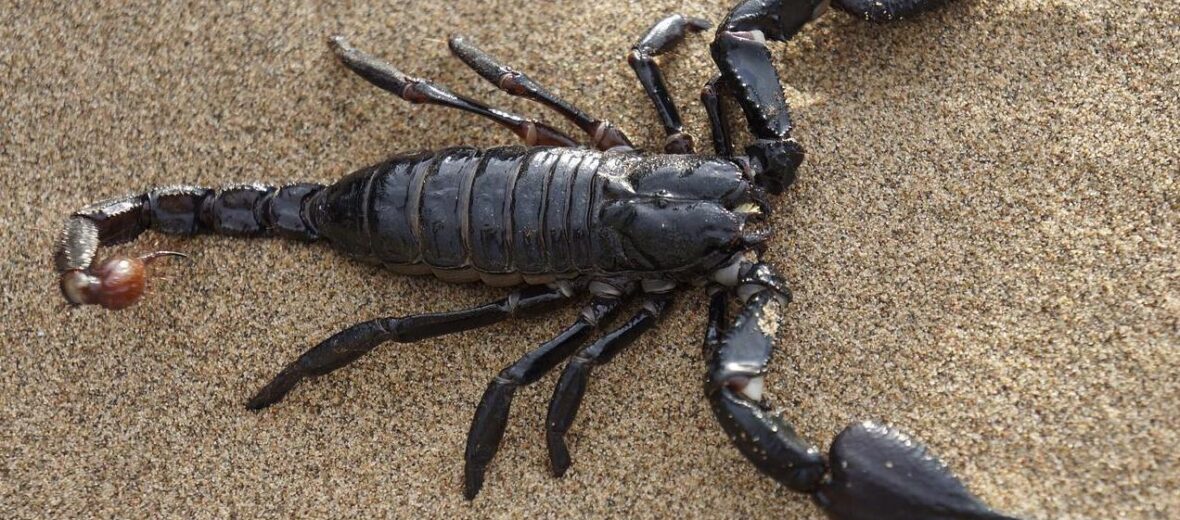
The emperor scorpion can be found in west Africa and prefers rainforest and Savanna habitats. While not the largest scorpion in the world, that title goes to the rock scorpion, also of Africa, they are still impressive in size. Even though they are not on the IUCN endangered species list, they are protected by CITES (Convention on International Trade in Endangered Species) from over-collecting that might (if left unchecked) drastically reduce their wild population.
First the Stats…
Scientific name: Pandinus imperator
Weight: Up to 2 ounces
Length: Up to 7.9 inches, from head to tail
Lifespan: Up to 8 years
Now on to the Facts!
1.) These scorpions are often confused with the giant Asian forest scorpion. But upon closer inspection one will notice that the exoskeleton of the emperor is more rough, and the telson (stinger bulb) is reddish, as are the pendipalps (claws).
2.) Just like all scorpion species, they are phosphorescent when under the moonlight or underneath a ultra violet light. Even their freshly shed exoskeleton shows greenish blue under an ultra violet light.
3.) Like other scorpions, these critters are nocturnal (active at night).
4.) Due to their ability to obtain water from the food they eat, they can go almost indefinitely without drinking standing water. However, they will drink from dew droplets.
5.) The emperor scorpion, like other scorpions, can enter into a type of stasis if food is scarce. This affords them up to nearly a year of survival without food.
But wait, there’s more on the emperor scorpion!
6.) While not overly potent, the venom of an emperor scorpion is classified on the pain index as being equal to that of a bee sting. I’ve been stung by an upset female. It wasn’t bad at all.
7.) Since arachnids don’t palpate (chew) their food, once their prey is subdued, they will then secrete special digestive enzymes onto their prey, which liquefies the food, turning it into a kind of oatmeal consistency, and transforming it into dinner.
Did you know…?
These scorpions are typically used in film and TV when a scorpion is needed. This is due to their impressive size and docile temperament.
8.) Reproduction occurs during the warmer months of the year.
9.) During courtship, the male will grasp the female with his pendipalps and move her into position over his spermatophore (sperm packet). The female then accepts the packet and is impregnated. The male then makes a hasty retreat, lest he be her next meal.
10.) Females undergo up to a 9 month gestation (pregnancy) that can yield up to 35 live young.
But wait, there’s still more on the emperor scorpion!
11.) When born, the young, still white (as they haven’t yet molted), will crawl onto mom’s back and stay there, protected, for several molts. Mom will often feed her young too.
Did you know…?
Their venom is considered a mild neurotoxin that causes paralysis in smaller prey. So, if you’re stung, you will often feel a tingling sensation afterwards.
12.) Emperor scorpions prey on a variety of insects and other terrestrial invertebrates. On rare occasions, smaller rodents are taken.
13.) Bats, birds, centipedes, lizards, small mammals, spiders, and larger scorpions all prey on emperors.
14.) Even though there are over 1,100 known species of scorpions, only less than 30 are considered medically significant (dangerous to humans or pets).
15.) Although not fool proof, generally speaking, the larger the scorpion species, the less potent their venom becomes. This is because larger scorpions tend to rely more on their powerful pendipalps to hold and crush prey and only use their venom when absolutely necessary.
Now a Short Emperor Scorpion Video!
Be sure to share & comment below! Also, check out the Critter Science YouTube channel. Videos added frequently!
Want to suggest a critter for me to write about? Let me know here.



